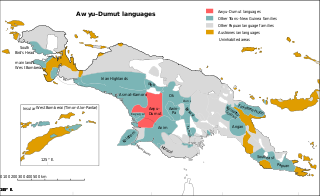Related Research Articles

The Papuan languages are the non-Austronesian and non-Australian languages spoken on the western Pacific island of New Guinea, as well as neighbouring islands in Indonesia, Papua New Guinea, Solomon Islands, and East Timor by around 4 million people. It is a strictly geographical grouping, and does not imply a genetic relationship.
Hiri Motu, also known as Police Motu, Pidgin Motu, or just Hiri, is a language of Papua New Guinea, which is spoken in surrounding areas of Port Moresby.
Donald Laycock (1936–1988) was an Australian linguist and anthropologist. He is best remembered for his work on the languages of Papua New Guinea.

Stephen Adolphe Wurm was a Hungarian-born Australian linguist.
The Piawi languages are a small family of Papuan languages spoken in the Schraeder Range of the Madang Highlands of Papua New Guinea that had been part of Stephen Wurm's Trans–New Guinea proposal. They are now connected to the Arafundi and Madang languages.
Elseng is a poorly documented Papuan language spoken by about 300 people in the Indonesian province of Papua. It is also known as Morwap, which means "what is it?" ‘Morwap’ is vigorously rejected as a language name by speakers and government officials.

The Greater Awyu or Digul River languages, known in earlier classifications with more limited scope as Awyu–Dumut (Awyu–Ndumut), are a family of perhaps a dozen Trans–New Guinea languages spoken in eastern West Papua in the region of the Digul River. Six of the languages are sufficiently attested for a basic description; it is not clear how many of the additional names may be separate languages.
The Pauwasi languages are a likely family of Papuan languages, mostly in Indonesia. The subfamilies are at best only distantly related. The best described Pauwasi language is Karkar, across the border in Papua New Guinea. They are spoken around the headwaters of the Pauwasi River in the Indonesian-PNG border region.

The Mek languages are a well established family of Papuan languages spoken by the Mek peoples. They form a branch of the Trans–New Guinea languages (TNG) in the classifications of Stephen Wurm (1975) and of Malcolm Ross (2005).

The Duna–Pogaya (Duna–Bogaia) languages are a proposed small family of Trans–New Guinea languages in the classification of Voorhoeve (1975), Ross (2005) and Usher (2018), consisting of two languages, Duna and Bogaya, which in turn form a branch of the larger Trans–New Guinea family. Glottolog, which is based largely on Usher, however finds the connections between the two languages to be tenuous, and the connection to TNG unconvincing.

The Kamula–Elevala languages are a small family of the Trans–New Guinea languages spoken in the region of the Elevala River.

The Mombum languages, also known as the Komolom or Muli Strait languages, are a pair of Trans–New Guinea languages, Mombum (Komolom) and Koneraw, spoken on Komolom Island just off Yos Sudarso Island, and on the southern coast of Yos Sudarso Island, respectively, on the southern coast of New Guinea. Komolom Island is at the southern end of the Muli Strait.

The East Strickland or Strickland River languages are a family of Papuan languages.
The Demta–Sentani languages form a language family of coastal Indonesian Papua near the Papua New Guinea border.

The Palei languages constitute a branch of the Torricelli language family according to Laycock (1975). They are spoken in mountainous regions of eastern Sandaun Province, Papua New Guinea.
Suki is a Gogodala-Suki language spoken by about 3500 people several miles inland along the Fly River in southwestern Papua New Guinea.
Molof is a poorly documented Papuan language spoken by about 200 people in Molof village, Senggi District, Keerom Regency.
Darrell T. Tryon was a New Zealand-born linguist, academic, and specialist in Austronesian languages. Specifically, Tryon specialised in the study of the languages of the Pacific Islands, particularly Vanuatu, the Solomon Islands, and the French-speaking Pacific.
The East Pauwasi languages are a family of Papuan languages spoken in north-central New Guinea, on both sides of the Indonesia-Papua New Guinea border. They may either form part of a larger Pauwasi language family along with the Western Pauwasi languages, or they could form an independent language family.
R. David Zorc is an American linguist primarily known for his work on Austronesian languages and linguistics, particularly the Philippine languages.
References
- 1 2 3 Pawley, Andrew. 2022. Thomas Edward Dutton (1935–2021). Oceanic Linguistics, vol. 61 no. 1 (Jun 2022), 602-613, doi : 10.1353/ol.2022.0009.
- ↑ Pawley, A., Ross, M. and Tryon, D. (eds). 2001. The boy from Bundaberg: Studies in Melanesian linguistics in honour of Tom Dutton. PL-514, x + 424 pages. Pacific Linguistics, The Australian National University. doi : 10.15144/PL-514
- 1 2 3 4 5 6 7 Pawley, Andrew. 2001. Tom Dutton: linguist. In Pawley, A., Ross, M. and Tryon, D. (eds), The boy from Bundaberg: Studies in Melanesian linguistics in honour of Tom Dutton. PL-514:1-12. Pacific Linguistics, The Australian National University. doi : 10.15144/PL-514.1
- ↑ Carrington, L. "T.E. Dutton: a personal bibliography". In Pawley, A., Ross, M. and Tryon, D. editors, The boy from Bundaberg: Studies in Melanesian linguistics in honour of Tom Dutton. PL-514:13-22. Pacific Linguistics, The Australian National University, 2001. doi : 10.15144/PL-514.13